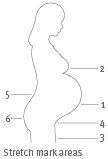Find out all that you need to know about stretch marks during pregnancy, what causes stretch marks, how you can (possibly) avoid these memorablia of pregnancy, and what you can do about them.
What are stretch marks?
Stretch marks are narrow streaks or lines that occur on the surface of the skin. Stretch marks, most often on the abdomen, are a common skin concern in pregnancy. While they pose no risk at all to mother or baby, the discomfort created if they lead to itching, not to mention the cosmetic effects of their appearance, can cause pregnant women much distress. A separate post on what to do to prevent stretch marks specifically addresses this concern.
What causes stretch marks?
 Our skin has two layers. When the skin begins to stretch too much to accomodate the growing baby, the inner layer of the skin begins to tear at places. These tears become visible through the upper layer and appear as stretch marks.
Our skin has two layers. When the skin begins to stretch too much to accomodate the growing baby, the inner layer of the skin begins to tear at places. These tears become visible through the upper layer and appear as stretch marks.
Research suggests that genetics plays a role: If your mother or sister got stretch marks during pregnancy, you’re more likely to get them, too. But it may vary depending upon some other factors too, viz. Rapid pregnancy weight gain can also make you more likely to get stretch marks. And darker-skinned women are less likely to get stretch marks as fair-skinned gals (plus they’re not as visible on dark skin).
When do stretch marks form?
While stretch marks generally become visible during the later months of pregnancy (around the sixth or
seventh month), some women will start to see them forming as soon as their bellies start growing. The American Pregnancy Association classifies their pattern of development into three stages.
- Stage 1: Early stretch marks will appear pink in color, and may also be itchy. The skin immediately around the stretch marks may also look ‘flattened’ and ‘thin’.
- Stage 2: Gradually, the stretch marks will enlarge in length and width and become a reddish or purple color.
- Stage 3: Once the stretch marks have matured, they lose their reddish/pink hue. In the months after pregnancy, they will start to fade and become pale white or silver. They may also appear slightly depressed and irregular in shape or length.
Where do stretch marks appear the most? 
Most women develop stretch marks on their abdomen during pregnancy, however it is also common to get them on the breasts, thighs, hips, lower back and buttocks. While they can appear anywhere on the body, they are most likely to appear in places where large amounts of fat are stored.
While it’s important to know why, how and where stretch marks form in pregnancy, even more important is to know how to help prevent them from forming in the first place. By following proper steps from the first trimester, your body will be better able to withstand the “big stretch” of pregnancy!
Do stretch marks ever go away?
The good news is that stretch marks usually become considerably less noticeable about six to 12 months after childbirth. The pigmentation fades and they generally become lighter than the surrounding skin (the color will vary depending on your skin color), but their texture will remain the same.
Related reading:
Pregnancy stretch marks – what can be done?
